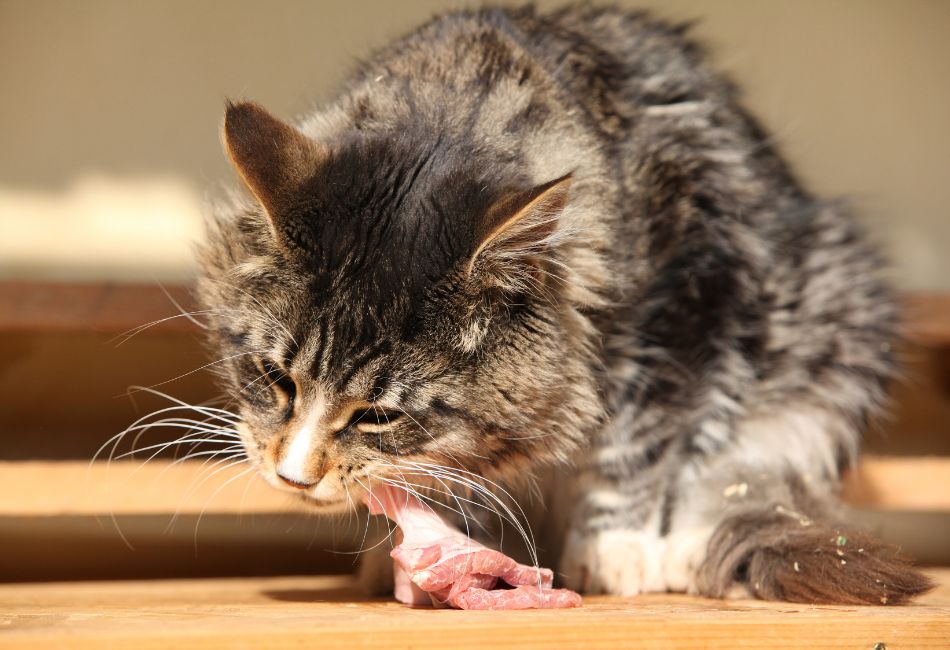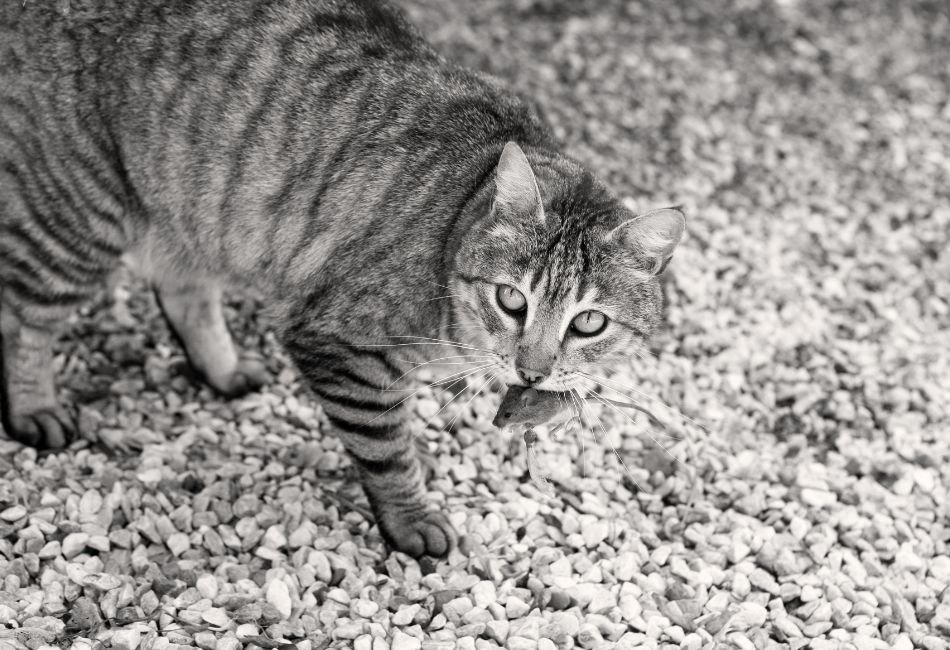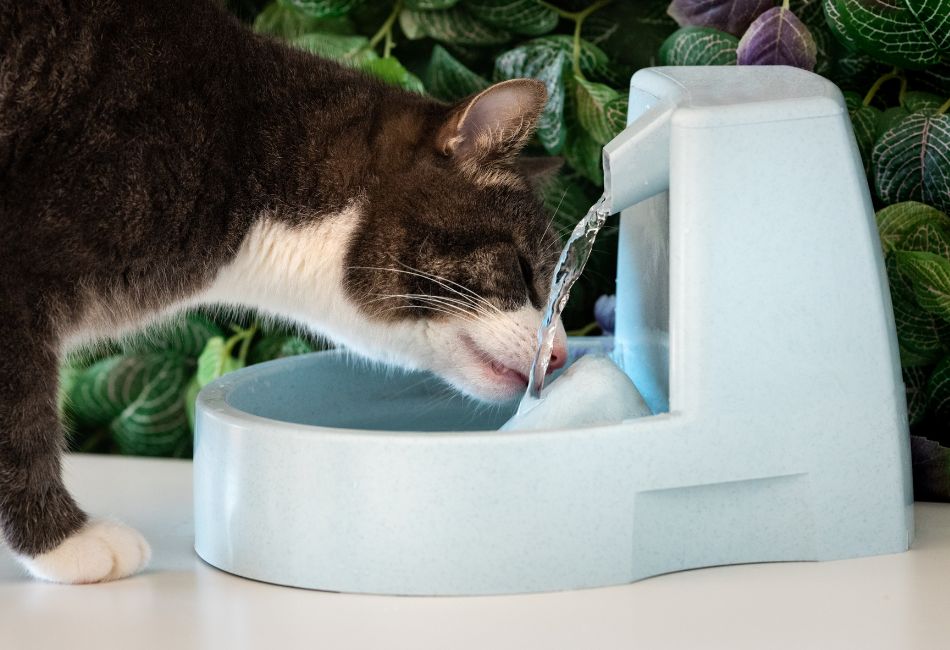In this post, we’ll explore the water needs of cats. Although dogs and cats are common animal companions, their needs are very different. How long can cats go without water? Not only are we going to answer that, but also explain how felines are able to use water even in the most inhospitable conditions.
There is not a cut and dry answer to this question because if you are feeding a fresh raw diet to your cat, invariably, you won’t see them hanging over the water bowl very often anyway. They acquire most of their moisture from their food. We’ll explain other scenarios where a cat’s water consumption may be in question though.
You’ll learn about different kinds of water and, most important of all, how you can give your special kittycat the best life possible. You’ll never have to find out the hard way how long can cats go without water.
By the way, we’ve posted a short glossary for you at the end of this article to explain some of the terms.
Your Feline’s Diet Determines Its Water Consumption

Have you ever thought about the many forms water takes in our lives?
- Out of the faucet
- In rain puddles
- In human-made puddles from watering gardens, hosing down things, water sports, birdbaths
- Morning dew and other condensation
- Natural sources such as streams, ponds, and lakes
- In FOOD! Juicy meat is where cats normally get most of their water
However, not all water is the same. Does the question “How long can cats go without water?” refer to water in bowls or any water at all? The answer is that it depends on the age, weight, and health of the cat as well as the temperature and humidity in the cat’s environment. Let’s look at dehydration next.
How to Identify Dehydration & What to Do
Most animals with backbones, including humans, consist of 60-80% water. Water keeps the body’s cells and tissues functioning:
- Transport–via blood, lymph, urine, and other fluids
- Electrical conduction–in the brain and heart and along cell membranes
- Digestion–from saliva to pee and poop
- Maintaining pH balance–Do you remember hearing about pH in school? It stands for “power of hydrogen” and refers to the concentration of hydrogen ions in a solution. What that means is how acidic or alkaline a solution is. Chemical reactions won’t take place without an environment with the correct pH. Discussions about pH are common when referring to medical lab tests, bee sting remedies, tooth decay, gardening and agriculture, cooking, ocean ecology, and climate change, among other things.
You can see that water is a necessary nutrient–without it we would all resemble strips of jerky. Felines are able to concentrate their urine so they need less water to survive. Since they gain most of their water from food, they have a low thirst drive.
For that reason, searching for water is not a major activity most of the time. How long can cats go without water? Some healthy cats without any water may live 3-5 days. A severe episode of dehydration weakens the immune system and can cause a lifetime of kidney and bladder problems, though. It is a serious and potentially fatal condition for any living thing.
Signs of Dehydration
Because measuring the amount of urine your kitty puts out is challenging, you can use check for these signs to assess for dehydration:
- Dry, sticky gums and mouth
- Loose, stiff skin that lacks stretchiness
- Loss of interest in surroundings and usual activities
- Sunken eyes
- Loss of appetite
- Panting
- Elevated heart rate
- Urinating less or passing dark, strong-smelling urine
- Recent diarrhea and/or vomiting can result in dehydration
How long can cats go without water? You want to prevent the above signs because they indicate advancing dehydration. If you believe your cat has become dehydrated, it’s time to contact an expert.
Your best bet is an open-minded veterinary office that provides integrative medical care options including modern Western medicine as well as alternative methods like herbalism and acupuncture. This site offers a vet directory in the US from the Holistic Veterinary Medical Association.
If you want to know more about when to take your cat to the vet, we wrote this article just for you.

Cats Are Designed to Get Their Water from Food
Current theories hold that today’s housecat descended from desert-dwelling felines in the Middle East tens of thousands of years ago. Because of the lack of precipitation, they evolved the ability to concentrate their urine in order to conserve water. Instead of relying on water holes and rivers, they absorbed most of their water from the prey they killed.
Most modern housecats retain a strong prey drive. How long can a cat go without water in the desert? It doesn’t matter as long as they can catch prey.
MDR – Minimum Daily Requirement Water
For these reasons, the ideal housecat diet consists of a variety of fresh, clean, raw, natural prey sources. Dry cat kibble only provides 6-10% of cats’ MDR (Minimum Daily Requirement) of water while a natural, fresh, wild vertebrate prey animal diet contains 60-80% water. Since preparing such a diet can be challenging but can be done, offering pre-made fresh frozen raw or freeze-dried is the next best choice.

If you can’t give your cat a daily raw diet, you can still supplement each meal with additions. Many new feeders of raw food notice that their cats consume less water from the bowl because of the high percentage of moisture coming from the food. You won’t need to worry about how long can cats go without water because they’re getting it just as they would in a natural environment.
An increasingly popular style of feeding pets is referred to as BARF: Biologically Appropriate Raw Food. One reason among many is that a BARF-type diet may contain as much as 70% of your pets’ daily water requirements. If you want some ideas for nutritious and delicious feline foods, check out our post on what cats like for breakfast.
Dry cat kibble only provides 6-10% of cats’ MDR (Minimum Daily Requirement) of water while a natural, fresh, wild vertebrate prey animal diet contains 60-80% water.
What if a cat doesn’t drink water but eats wet food or raw food?
If you’re concerned because you don’t see your kitty drinking from the bowl, it might be happening while you’re not watching. Many pets are nervous about their vulnerability to attack while they’re distracted by eating and drinking. Your cat might also have discovered alternative water sources such as the bathtub or the toilet.
As we mentioned, quality raw or wet/canned food is the next best thing to supplying your cat with adequate water the natural way. Each species of pet as well as each age group has individual nutritional needs, so you need to choose what’s right for your cat. The most healthful food contains few or no artificial dyes, fillers, preservatives, or unidentified ingredients. Cats don’t need food coloring, cornmeal, or meat scraps that could be anything from mouse tails to euthanized cat parts.
The most healthful food contains few or no artificial dyes, fillers, preservatives, or unidentified ingredients. Cats don’t need food coloring, cornmeal, or meat scraps that could be anything from mouse tails to euthanized cat parts.
Water for Cats to Drink
Like dogs, cats have highly acidic stomachs with a pH ranging from 1.0-2.5. That’s almost as acidic as it can get! Having a low pH (high acid) means that raw meat protein as well as less easily digestible tissues such as bone, gristle, and fur are broken down. Most pathogens can’t survive in such an environment.
Even so, most cats prefer water from clean water sources. Many cats LOVE a natural water source and will often drink water that has been sitting outside for some time. Think of all those tasty little insect flavor bits!

Stomach acid won’t dissolve toxic chemicals, though. The quality of tap water varies from location to location as well as from variations in atmospheric pollutants and groundwater contaminants. Cats can definitely smell the presence of chemical additives like chlorine.
Bottled water is proven to vary from source to source regardless of claims on the label. Distilled water is reportedly pure originally but may contain substances leached from the plastic containers. The most reliably safe water for your pets as well as the humans in your household is processed by a home purification unit. To give you an idea of an efficient home system, here is a link for an under-counter reverse osmosis system.
The Best Water Bowls for Cats
How long can cats go without water? There’s no reason why your cat–and the neighborhood cat colony–should ever have to go without water. Give them lots of safe places to drink. Tuck different-sized bowls in a variety of locations so there’s more than one watering hole. Most cats don’t like feeling their whiskers bent by the rims of bowls because whiskers have so many nerves at the roots.
Imagine how you would feel being tickled or blown on every time you opened your mouth to eat or drink! Use water bowls with wide openings. A wide base is advisable, too, so the bowl won’t turn over. Although anything can be used to hold water, a stable metal such as stainless steel is easy to keep clean. Scratches in plastic, ceramic, and glass often collect who-knows-what and acquire a bacterial film just like dirty teeth.

Specialty bowls: For outdoor pets, large bowls are available that generate low heat in sub-freezing weather by using either electrical or battery power. They don’t get hot, but just maintain the water above freezing. Likewise, you can get insulated water bowls that keep water cool for hours if your cat prefers cold water. Some cats even like a bobbing ice cube or two in their bowls.
Other temptations: But wait! There’s more! Not only will bowls in multiple locations encourage your kitties to drink, but you can add flavor to the water. Assuming that you’re cleaning the bowls daily and replacing the water, add a few drops of clam juice, tuna juice, or salmon juice, or unsalted chicken broth without any garlic or onion. Last but not least, sprinkle a bit of catnip to make catnip tea!
The Optimal Watering Hole: Cat Water Fountains
Most cats love running water. In the wild, flowing water is usually fresher and cleaner than standing water. Another reason for their preference is that the feline sense of hearing is sharper than their vision. They can hear running water from a distance. Their sharp visual ability to detect motion responds to the water’s flickering movements.
In addition, most cats like high places to perch, and most home faucets are higher up than water bowls on the floor. A stream of running water doesn’t confine their whiskers in the way that small bowls do. Finally, running water is just more fun to play with.
Someone someplace adapted small water fountains for cats to use, and the market has exploded. They’re available in a wide variety of materials and prices. Many veterinarians recommend them because they often encourage cats to drink more water. Fountains are ideal if they’re kept clean and refilled with fresh water often.
They’re not a necessity but they will provide your kitty with abundant fresh water to enjoy in a novel way. Is this manipulation to get you to buy expensive fun toys? Maybe. But why not? You love your fur kids. How long can cats go without water? well, how long can cats go without playing?
Location, Location, Location
Many people say “cats are picky,” but cats have good reason to be picky. It’s a matter of survival. In terms of the location of their water bowls and food dishes as well as litter boxes, they want to avoid other cats and marauding animals. Most all cats prefer their food and water located away from their litter boxes.
How long can cats go without water? You won’t win in a contest between you and your cat about where to put their personal items! You will win by understanding their need for safety, privacy, cleanliness, and their convenience. To learn more about what’s important to cats in their personal environment, look at our post on litter boxes.
FAQ–Frequently Asked Questions
Do cats drink water or milk?
Milk contains water but is classified as a special type of food. What’s more, milk is species-specific, produced by lactating females to help their young grow quickly. Cow’s milk is made up of proteins and other nutrients for young ruminant herbivores.
Cat’s milk is made up of proteins and other nutrients for young carnivores. Not only is milk unnecessary for adult cats, but many cats are lactose-intolerant, meaning that they can’t physically digest the kind of sugar found in milk. It can result in abdominal cramps and diarrhea.
Can cats get infections from water?
Contact with areas of standing water, especially outdoors in warm weather, can cause pythiosis, also called water mold infection. It can be fatal if not treated early. Leptospirosis is another serious infection that infected animals can pass on to other animals as well as humans via contaminated water.
Can cats get water by eating snow?
Although unmelted snow can provide water, it lowers the body temperature. The critter eating the snow uses up valuable energy trying to maintain body warmth brought down by the frozen flakes. What’s more, melted snow in puddles often contains oil, antifreeze, and other toxic substances.
Final Thoughts
We’ve given you lots of information on how long can cats go without water and how to get cats to drink more water. Cats are intuitive beings and we have a lot to learn from them. We have one last suggestion for you to try–we invite you to test this with your pets.
You know that felines of all kinds love to sit in boxes, so much that many of them will even sit in the middle of corners painted onto a flat surface. If your cat isn’t drinking enough, what might happen if you painted a fake box in a safe, quiet, low-traffic spot near the location of your cat bowl? Let us know!
Glossary
Carnivore: An animal that survives primarily on flesh and organs from other animals; examples are cats and sharks.
Herbivore: An animal that survives primarily on plants; examples are cattle and ostriches.
Lactating: Actively producing milk from mammary glands.
Omnivore: An animal that survives on a variety of foods from animal and plant sources; examples are humans and dogs.
Osmosis: The process of a liquid with little or no dissolved or suspended material being drawn through a membrane to a liquid on the other side of the membrane that contains dissolved and suspended material, thus balancing the concentration of material on both sides of the membrane.
Pathogen: A disease-causing microorganism.
Permeable: Able to allow a liquid to permeate or pass through; examples of semi-permeable membranes include tea bags and coffee filters that allow tiny particles to pass through special paper.
pH: The acidity or alkalinity of a substance. Neutral is around 7, while lower numbers rate acid intensity and higher numbers rate alkaline intensity.
Reverse osmosis: The process of a liquid with a large amount of dissolved or suspended material being drawn to pass through a semi-permeable membrane to a liquid on the other side that contains little or no dissolved or suspended material, thus balancing the concentration of material both sides of the membrane.
Ruminant: An animal that chews its cud; examples are goats and giraffes.
Vehicle: Anything that serves as a source of contamination by disease-causing agents; water can carry viruses, bacteria, parasites, neurotoxins, and chemical contaminants.
Vertebrate: Any animal with a backbone (vertebrae)
For More Info
How pH Affects Our Everyday Lives:
https://collegedunia.com/exams/importance-of-ph-in-everyday-life-science-articleid-307
Purifying water with reverse osmosis:
https://science.howstuffworks.com/reverse-osmosis.htm
Possible reasons why cats love to sit in boxes:
https://www.smithsonianmag.com/smart-news/if-i-fits-i-sits-experiment-shows-felines-also-sit-illusory-boxes-180977681/








